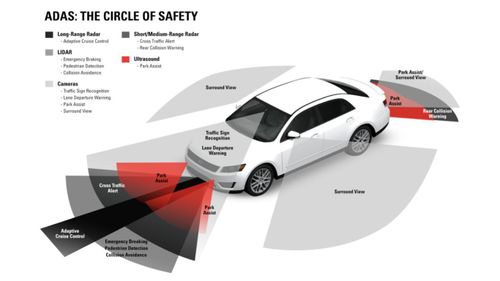How far has the ADAS features come? Level 5 ADAS does not need human assistance
By Mohit Kumar

24220 Views
Look how far the ADAS features have come, the Level 5 ADAS feature can make your car fully autonomous.

In recent years, the automotive industry has witnessed significant advancements in the field of Advanced Driver Assistance Systems (ADAS).
These systems, comprised of various technologies and features, aim to enhance the safety, comfort, and overall driving experience for motorists. From the early stages of Level Zero to the current Level 4 autonomy, ADAS has come a long way, revolutionizing the way we interact with our vehicles and the road.
ADAS Features Evolvement in Cars

Level Zero ADAS
It is also known as "No Automation," which refers to the traditional driving experience where the driver has full control over the vehicle without any assistance from technological systems. While there were some safety features like seatbelts and airbags present, the concept of ADAS was yet to take shape.
Level 1 ADAS
As technology progressed, Level 1, known as "Driver Assistance," emerged. This level introduced features like cruise control, where the vehicle maintains a constant speed set by the driver. Additionally, it included lane departure warning systems, which alerted drivers when they unintentionally deviated from their lane. These initial ADAS features aimed to provide basic assistance to drivers, improving safety and reducing fatigue during long drives.
Level 2 ADAS
Level 2, referred to as "Partial Automation," marked a significant step forward in ADAS development. It introduced features like adaptive cruise control, which not only maintained a set speed but also adjusted the distance from the vehicle ahead. Lane-keeping assistance was also introduced, actively assisting the driver in staying within the lane. These features demonstrated the capability of the vehicle to control aspects of the driving task, but the driver still had to remain engaged and ready to take over at any moment.
Level 3 ADAS
Moving up to Level 3, known as "Conditional Automation," we enter the realm of semi-autonomous driving. At this stage, the vehicle has the ability to handle certain driving tasks under specific conditions. For example, Traffic Jam Assist was introduced, allowing the car to control acceleration, braking, and steering in heavy traffic situations. However, the driver must still be prepared to intervene when the system requests assistance.
Level 4 ADAS
Level 4, referred to as "High Automation," represents a significant leap towards fully autonomous driving. At this level, the vehicle can perform all driving tasks under specific conditions and does not require driver intervention. This level of autonomy is typically limited to specific geographic areas or well-defined roadways. While Level 4 vehicles are capable of operating autonomously, they still have provisions for the driver to take control if necessary.
The evolution of ADAS features from Level Zero to Level 4 has been driven by advancements in sensor technology, artificial intelligence, and computing power. The integration of various sensors, such as radar, lidar, and cameras, enables the vehicle to perceive its surroundings accurately. These sensors work in tandem with sophisticated algorithms and AI systems to interpret the data and make informed decisions.
Additionally, the advent of high-speed data connectivity and cloud computing has opened up new possibilities for ADAS features. Real-time traffic information, map data, and over-the-air updates play a crucial role in enhancing the capabilities of ADAS systems. Furthermore, the fusion of data from multiple sources enables more comprehensive situational awareness, improving safety and driving efficiency.
Upcoming Level 5 ADAS Feature
As we look to the future, the development of Level 5, also known as "Full Automation," is the ultimate goal of ADAS. At this stage, vehicles will be capable of handling all driving tasks in any condition or location without the need for human intervention. Achieving Level 5 autonomy presents unique challenges, such as ensuring regulatory frameworks, infrastructure support, and addressing ethical considerations. However, the advancements made from Level Zero to Level 4 provide a solid foundation for continued progress in the field.
Level 5 autonomy represents the pinnacle of self-driving technology. Unlike Level 4 autonomy, where certain conditions may still require human intervention, Level 5 vehicles operate entirely autonomously. These advanced vehicles are capable of navigating any road and driving under all conditions without the need for human input.
In fact, Level 5 vehicles eliminate the need for traditional controls like steering wheels, gas pedals, and brake pedals. At this stage, the human driver transitions into a passenger, relinquishing control to the vehicle's sophisticated autonomous system. Level 5 autonomy marks a significant leap forward in transportation, revolutionizing the way we perceive and interact with vehicles.